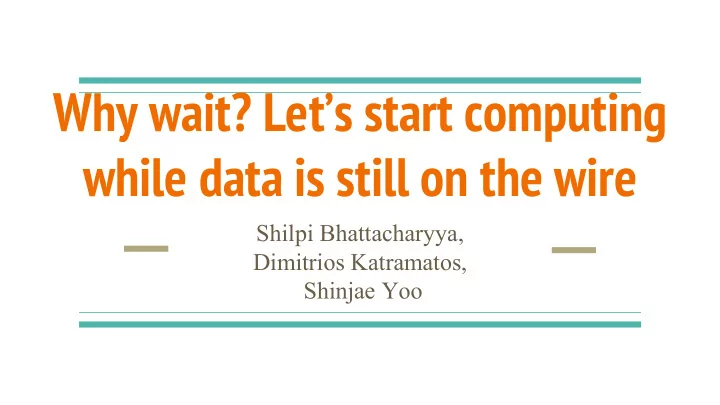

Why wait? Let’s start computing while data is still on the wire Shilpi Bhattacharyya, Dimitrios Katramatos, Shinjae Yoo
Problem we are trying to solve With the ever increasing data in transit, storage and early analysis as well as computation is a big challenge. Why not compute(Analyze, visualize, predict etc.) while data is still in flight? Can we? Sure! Let’s attempt to compute in network fabric.
Talk in a nutshell ● “computing in network fabric” - Analysis on Wire(AoW) framework. ● Present the functionality of AoW with three examples on Forex data, Clickstream data, Solar Sensor data. ● Overall performance comparison of the AoW framework in varied scenarios and Analysis. ● Novelty of our work from all existing computing paradigms. ● Limitations of the AoW Framework. ● Summary and Future work .
A New Computing Paradigm!! ● Till now we have known to do computations on data at the edge or by redirecting to Cloud. ● We suggest “Computing in the network fabric”. ● The framework designed to solve this problem is named the Analysis on Wire(AoW) framework.
Analysis on Wire(AoW) Framework with Compute- capable Network Nodes Fig. Analysis on Wire Framework(AoW)
AoW Architecture - Implemented Model Fig. Working model of the Analysis on Wire(AoW) Framework
Use of Network Service Headers in AoW The traffic checker encapsulates NSH headers into the incoming data packets. NSH headers are transported through the UDP protocol. At the end of the chain, the SI(service index) is reduced to zero Fig. Network Service Header (NSH) UDP Stack
Components in the Framework A Docker-based Service Function Chaining(SFC) architecture with an OpenDayLight Controller. ● Traffic Checker ● Forwarder ● Computing Unit(CU)(Data Processing module + Algorithm module) Since, we are sending TCP packets, we need a bidirectional framework. Accordingly, we have two traffic checkers, one at source and other at destination. The forwarders with their CU are applicable for both directions.
AoW can provide an array of benefits ● Saving resources in Datacenters or Cloud Storage ● Early decision making ● Pre-awareness of impending device failures ● Faster results ● Cybersecurity Fig. Brookhaven Lab's Scientific Data and Computing Center Group
Examples on the AoW Framework
Visualization and Pattern Recognition on Forex Data Fig. Forex Data during an intermediate processing at CU The green line indicates the ask prices and the blue line represents the bid prices. Fig. Forex data visualization
Patterns with greater than 70% similarity The blue line is the current pattern in question and the green line is the matching similar pattern. %change = (currPt - startPt)*100/startPt sim i = 100.00 - abs(%change(eachPattern[i], patForRecog[i])) Similarity = (∑ i sim i )/∑i
Clickstream Analysis by Media Publishers Fig. Clickstream Payload from a Single Page Fig. User Clickstream Data Statistics
Solar Sensors Streaming Data Analysis Fig. Solar Sensor Payload at the Data Processing Unit of CU Fig. 23 Solar Sensor Readings at two timestamps
Performance Comparison in Chained and Unchained Path
Computation time difference between AoW and Direct path 𝚬 T We denote here as the total time difference experienced by computation on streaming data packets through the framework vs directly to the destination and computation thereafter. The minimum overhead is 44 seconds in case of Forex data at around 60 packets every second. So, the setup does not seem ideal for this kind of computation unless some acceleration is applied at the computing unit or for NSH encapsulation and associated operations.
What about the Prevailing Technologies and Related Work? ● Cloud Computing - storage is performed in virtual data centers that are put together dynamically. Example - Amazon AWS. ● Edge Computing - facilitates the operation of compute, storage, and networking services between end devices and data centers. ● Mist Computing - latest paradigm involving computing in the very end devices found at the edge of the network to assist in the motion of data towards the fog and the cloud. All paradigms are intimately linked with the Internet of Things (IoT)
Limitations of the AoW Framework ● Operates in a Congestion-controlled environment. ● Guarantee of no data loss but, since underlying packet in NSH encapsulation is TCP, if lost , sender might repeat sending creating more congestion. ● Not so efficient for multi-step huge computations - may need to use multiple nodes or some acceleration.
Summary and Future Work ● Tremendous opportunity to perform computations on wire. ● If data rate exceeds the capacity of a basic AoW framework - utilize multiple parallel computing units with a divide and conquer approach. ● Independent Data Packets - defragmentation on the packets to do complex computing. ● Acceleration of computation on the AoW framework by employing GPUs and FPGAs. We simply want to go far beyond the bounds of networking and virtual network functions and devise a framework that can execute any reasonable algorithm on streaming data, while also investigating the behavior and performance of such algorithms to determine the feasibility of solving certain problems on the wire.
Thank You
Questions?
Recommend
More recommend